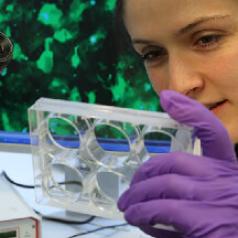Perfluorinated, PFAS, PFOS, PFOA, PTFE... These terms seem familiar to you but you don't know exactly what they mean? These chemical substances, used for decades in many daily products (food packaging, waterproof textiles, kitchen utensils, and non-stick coatings), are today the subject of particular attention. The reason? They represent a potential risk for our environment.
At L'Oréal, we have taken the lead: from 2018, we chose to gradually eliminate all PFAS from our products. Today, more than 99% of the relevant portfolio has been reformulated without PFAS, and we will reach 100% by the end of 2024, well ahead of regulatory deadlines.
But what exactly are PFAS?
According to the OECD definition of July 2021, PFAS are “fluorinated substances that contain at least one fully fluorinated methyl or methylene carbon atom.” In other words, any chemical with at least one perfluorinated methyl group (-CF3) or perfluorinated methylene group (-CF2-) is a PFAS.
These are very stable and resistant molecules, which explains their use in many products. There are more than 10,000 types, the best known of which are PFOA, PFOS and PTFE. At L'Oréal, we have never used PFOA or PFOS, and we have completely removed PTFE from our products.
Where are PFAS used and why?
Per- and polyfluoroalkyl substances (PFAS) are a large group of chemicals that have been widely used since the 1950s. Their unique properties make them very effective for impregnating textiles, making firefighting foams, resistant waxes, and even cosmetics.
These substances were valued for their versatility, strength and stability. They made it possible to create high-performance products, offering concrete advantages to manufacturers and consumers.
In cosmetics, PFAS are used for specific technical applications:
- Pigment coating: for long-lasting and more intense color.
- Film-forming agents: for a smoother texture in skincare and better long-lasting effect of makeup.
- Waterproofing effects: for products resistant to water and humidity.
Why are PFAS questioned?
The major problem of PFAS is their persistence in the environment: their stability, which means that they do not degrade naturally. Some of these substances can also gradually accumulate in living organisms, thus contaminating the entire food chain up to humans.
Among PFAS, PFOA is under particular scrutiny. Classified among carcinogenic, mutagenic and reprotoxic substances (CMR), it has long been banned as a cosmetic ingredient and has always been banned in L'Oréal formulas.
Concerning the potential risks of PFAS in cosmetics for human health, some studies, in particular the latest assessment report from the Danish authority, demonstrate that the current concentrations and conditions of use do not present a risk, taking into account the low skin penetration of these substances.
Towards stricter regulation of PFAS
Facing health and environmental risks linked to PFAS, legislation is evolving towards stricter supervision of their use throughout the world to limit their environmental impact.
For example, the Stockholm Convention, an international agreement aimed at banning certain polluting products, has already established the progressive elimination of PFOA, its salts and its compounds. The latter has also been prohibited by the European regulation on persistent organic pollutants since July 4, 2020.
Europe is going even further: a restriction process (via the Chemistry regulation, REACH) is being developed to regulate the use, manufacturing and marketing of all PFAS in all sectors of activity. A total ban is envisaged by 2028 for cosmetics.
Our commitments
At L’Oréal product safety is our top priority and all our products are safe for consumer use. As a responsible company that is deeply involved in scientific research, L’Oréal is committed to sustainable innovation and rigorously applies the latest scientific developments to constantly improve the performance and sustainability of its products.
Since 2018, we have chosen to gradually phase-out all PFAS from our products to be in line with our L'Oréal for the Future ambitions. Because of the wide range of properties of PFAS, we have to look for a specific substitute for each PFAS. We also work with combinations of raw materials (e.g. waxes, fats, minerals) to replace these ingredients in our formulas and maintain their original sensoriality.
Today, more than 99% of the relevant portfolio has been reformulated without PFAS, and we will reach 100% by the end of 2024, well ahead of regulatory deadlines. After this date, older references may still be found on the market until retailer stocks are exhausted.
Furthermore, all our products, including those in the reformulation phase, meet the high standards of safety, performance and respect for the environment. L'Oréal, as a responsible beauty company, is determined to complete this reformulation process well before regulatory deadlines and to offer its consumers ever more responsible products.























